|
6/13/2014 Adrenal FatigueChronic stress is a condition that many of us face as the pressures from work, family commitments, finances, watching the news and lifestyle choices combine to leave us feeling fatigued and cranky. Over time we come to believe that this is our new normal state of being and the body has a difficult time disregulating these reactions in the body, even at night when we are sleeping. The adrenal glands are located above the kidneys and they secrete hormones such as adrenaline and cortisol, the chemicals responsible for the fight or flight response. Our heart rate increases, blood is sent to the muscles of arms and legs to prepare us for action, and blood is shunted away from the digestive and reproductive systems. When this reaction is a short lived event, such as when someone cuts us off in traffic, we are usually able to return to a calmer internal state after a few minutes. However, prolonged stress can be taxing on the adrenal glands as they continually work to provide the blood stream with the hormones that give us the energy to act and react to what our body perceives as threatening situations. This week's practice will focus on gentle movement of the upper abdominal region, middle back and lower rib cage - the area of the third chakra, Manipura. Here the fire element rules the metabolism of food into energy and the transformation of our experiences into wisdom. We will combine gentle lateral bending and twisting to stimulate deeper breath to refresh tidal volume (the often stagnant air in the lower lobes of the lungs that can lead to increased acidity in the blood stream). A trio of restoratives finish the practice to provide the third chakra region of the torso the support it needs to rejuvenate the organs found here, the stomach, spleen, kidneys, liver, gal bladder, pancreas and adrenal glands. 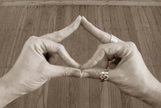 Vajra MudraTouch the tips of the thumbs and index fingers together then bring the right had and left hands together and join the joined thumbs and indexes as well as the tips of the middle fingers together. Let the ring and pinkie fingers curl softly inward. Hold the hands at the solar plexus. Benefits: Activates energy and vitality 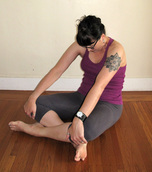 Seated Barrel Roll Sitting cross-legged begin to move the upper abdomen around in a circle. Inhale as you arch the back and move the abdomen to the right, then exhale as you round the back (shown) and circle the abdomen to the left. Repeat both directions 5-10 times. Therapeutics: Awakens the diaphragm for deeper breathing and massages the upper digestive organs. 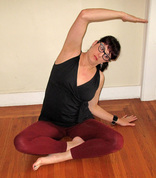 Seated Lateral Bend Begin seated cross-legged and place the left hand on the floor beside the hip. Inhale and raise the right arm diagonally across the body and reach it overhead to the left. Bend the left elbow towards the body and keep that shoulder released down the back to help support the weight of the body. Keep both sit bones grounded into the floor. Exhale and return to the center. Repeat to both sides 5-10 times with the breath. Therapeutics: Opens side rib cage and facilitates breath throughout the torso. Gently warms up the low back and shoulders. 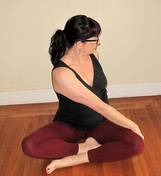 Seated Twist Begin sitting cross legged and inhale to draw the arms overhead. Exhale and first twist to the right bringing the left hand to the right knee, the right hand on the floor behind you. Inhale return to the center with the arms overhead. Exhale and twist to the left (shown) bringing the right hand to the left knee, the left hand on the floor behind you. Repeat with the breath 5-10 times. Therapeutics: Gently opens the ribs, massages the organs and muscles along the spine. 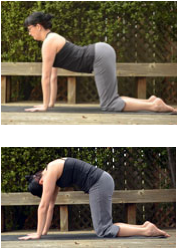 Cat/Cow with breathing pattern variation Begin on all fours in a table position. As you inhale arch the back into the cow tilt drawing breath down into the front of the ribs as the diaphragm drops towards the belly. Exhale to table. Inhale into the cat, rounding the back and drawing breath into the back of the ribs. You may not be able to inhale into cat as deeply so do not force the breath in either position. Exhale to table. Repeat 5 times with the breath. Therapeutics: Refreshes the tidal volume in the lungs, the stagnant air that must stay in the lungs to prevent them from collapsing.  Table Twist Begin on all fours. Inhale lift right arm out to side. Exhale press right arm under left armpit lowering right shoulder to floor. Continue to press left hand into floor for balance. Can also raise left knee up pressing left ball of foot into floor. Be careful not to put too much pressure on your head. Therapeutics: Opens upper back, shoulders and rib cage.  Supported Side Bend Lie on the side with a bolster or rolled blanket under side ribs and a second bolster to support the head Extend bottom arm between the two bolsters. Begin with both knees bent then try extending top leg in line with the rest of the spine. Raise the top arm overhead and support with the head bolster. Breathe into the rib cage that faces the ceiling. Rest 3-5 minutes per side. Therapeutics: Opens both sides of thoracic region increasing breath capacity 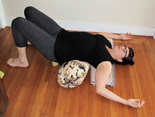 Supported Setu Bandha Sit in front of a bolster with a long folded blanket on the other side. Lay back over bolster and place shoulders on blanket, head on floor as you lift hips away from the floor. Place block under hips and turn toes slightly in. Rest arms in cactus with palms facing upwards. Rest up to 5 minutes. Therapeutics: Opens front of belly and solar plexus allowing for increased breath in these areas as well as tractioning the lower spine.  Supta Balasana (Supported Child's Pose) Kneel straddling a long bolster. Place a second bolster over first with end of bolster in front of your low abdomen. A third bolster can go under the far end of the second bolster or use a folded blanket or block to support under it. Extend front of body over second bolster and rest forehead on backs of hands. Rest up to 5 minutes as you breathe gently into the kidney area. Therapeutics: Creates a calm, grounded space to get away from the demands of daily life 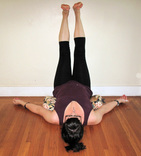 Viparita Karani (Inverse Seal Pose) Sit beside wall. Swing legs up wall as you lay back on mat. Place either a bolster or long-folded blanket under the lumbar curve, the buttocks should not be on floor. Lay arms out to sides with palms facing up. Rest at least 10-15 minutes, then roll over to release. Therapeutics: Activates the Relaxation Response, reduces swelling in the legs and feet, balances the nervous system, good if you have been sitting or on your feet all day
2 Comments
6/25/2014 01:02:48 am
Thank you, Cheryl, for your generosity in sharing so much information, in this case wonderful info on adrenal fatigue. As a teacher in Atlanta, I am amazed at your level of knowledge and your willingness to share. May you be blessed.
Reply
5/11/2024 01:51:43 am
Really amazing ways to reduce adrenal fatigue. Yoga and related practices works great for the overall well being.
Reply
Leave a Reply. |
Index:Archives:
September 2022
I attend Cheryl's class regularly and feel that my practice has improved immensely over the past few years due to her expert coaching. Her teaching style is clear and compassionate and her previous experience in teaching adults is evident in her organized approach and easy to understand instructions. I also appreciate that Cheryl not only teaches us about how to correctly position ourselves, but also touches on many aspects of yoga philosophy, which in turn has deepened my personal practice and heightened my awareness of the connection between mind and body, breath and relaxation. |

 RSS Feed
RSS Feed
